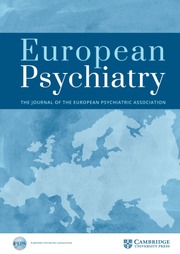No CrossRef data available.
Article contents
Exploring depression in adolescents: How depression changes in early onset psychosis (EOP), clinical high risk (UHR) and clinical control (CC) patients
Published online by Cambridge University Press: 13 August 2021
Abstract
Depression is very common in adolescent patients and impacts on their quality of life and functioning. Indeed, depression is an important clinical aspect for treatment, outcome, and prognosis.
This pilot study investigated the factorial structure of the Calgary depression scale for schizophrenia (CDSS) in a sample of help seeking adolescent patients, stratified in three clinical diagnostic subgroups: early onset psychosis (EOP), clinical high risk (UHR) and clinical control (CC). The relationships between these factors and SIPS domains and subjective experiences were also explored.
Sixty-nine subjects were examined to assess the severity of depressive symptoms and the degree of subjectively felt cognitive-affective vulnerability (i.e. basic symptoms)
Principal component analysis revealed CDSS to include two main factors, namely: “guilty idea of reference-pathological guilt” (factor I), “depression-hopelessness” (factor II). Two factors revealed multiple correlations with SIPS domains and subjective experiences.
The results confirm the dual factorial structure of CDSS previously reported in the literature in adult samples, further increase our knowledge of the psychopathological components of depression in adolescents, and strongly suggest that CDSS can also be used in early diagnostic settings
No significant relationships.
- Type
- Abstract
- Information
- European Psychiatry , Volume 64 , Special Issue S1: Abstracts of the 29th European Congress of Psychiatry , April 2021 , pp. S85
- Creative Commons
- This is an Open Access article, distributed under the terms of the Creative Commons Attribution licence (http://creativecommons.org/licenses/by/4.0/), which permits unrestricted re-use, distribution, and reproduction in any medium, provided the original work is properly cited.
- Copyright
- © The Author(s), 2021. Published by Cambridge University Press on behalf of the European Psychiatric Association



Comments
No Comments have been published for this article.